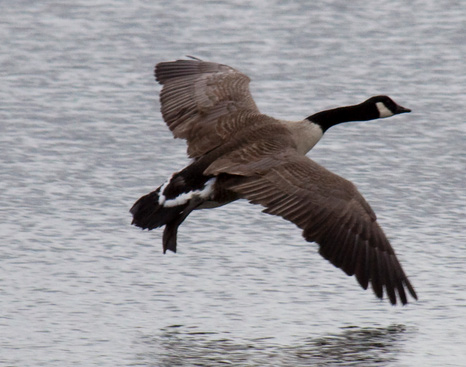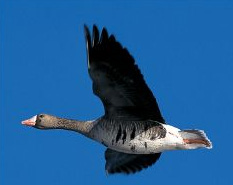GEESE
GEESE
As a rule of thumb, geese are larger than ducks. Weighing up to 15 pounds, some may live for as long as a quarter of a century. Predictably, those geese are the hardest to hunt due to their experience and general caution. Geese rarely breed in their first season. There are no obvious differences in coloration between male and female geese. When geese migrate, their flocks may number in the tens of thousands, and usually fly in a distinct V-formation. Their wingbeat is visibly slower than ducks, at least to the trained eye. Geese flocks usually contain one or two family units of four to six birds. The greater distance traveled in a migration, the more flocks join the group, explaining almost overwhelming number of geese sometimes witnessed. Geese return to the same general area each year, thanks to a strong homing instinct.
They are also likely to return to the same spot on the water day after day until it no longer yields food. In the fall, their diet consists of wheat and oats, barley shoots, green plants, and grasses. When not feeding on the water, geese will look for food in open fields, but only if they can establish good visibility to avoid predators hunting geese on dry land tends to yield larger game, with some of these birds growing to a wingspan of nearly six feet. Some geese live as long as 25 years and become extremely cautious in their autumn years. These seasoned birds will slowly and meticulously scan a spot before landing to feed. More often than not, they will veer off and begin to search for a new spot.

One of the most popular types of goose for game hunting is the Canada goose. These birds breed in the northern parts of the United States, as well as in the country of their namesake. It is a common misnomer to refer to these majestic birds as Canadian geese, rather than Canada geese, which is their actual name. A specific specimen may, in fact, be Canadian, and, therefore, a Canadian goose, but it more accurate to stick with the correct title.

Most people recognize the unique pattern of Canada geese. They have black heads with white chin bars. Their backs are gray or brown with a white belly. There are actually twelve different varieties of the Canada goose. Lesser known game geese include Snow geese, Ross geese, Brant geese, and the White-Fronted, or speckle bellied, geese. The Snow goose and the Ross goose are often mistaken for one another, due in part to the fact that they tend to travel together. Both are mostly white with dark wing tips. The Snow goose, however, is smaller, has a stubbier bill, and a faster wing beat. The Brant goose has a very rapid wingbeat. Its head and chest are black. Its neck is black with white streaks. White-fronted geese have the common nickname speckle bellies for an obvious reason. Their undersides are primarily white but have dark brown speckles. Their backs, necks, and heads are brown, with distinctive white facial patch ringing their pinkish bills.
Hunting geese has its own special charm, unlike any other. Whether in the field or on the water, an experienced hunter will be in place before dawn. His reward is the stillness that comes with the waning night, just before the first honk of the goose’s new day. This moment combines peace and anticipation. Hunters know the moment and savor it. Unlike the thrill that accompanies the first kill, this is an almost spiritual joy. The moment of reflection and excitement makes all of the work, preparation, and even early rising, well worthwhile.
Much of the important work in goose hunting, as in any hunting, is done well in advance. Goose hunters scout fields and water on in the midmorning and late afternoon the day before a hunt and take note of where the great birds are landing and feeding. Since geese return to the same spots for several days, it’s always a good bet that such scouting will yield good opportunities for a kill. Hunters use decoys to draw in the geese for both water and land, but more are recommended for the latter. Hunting Canada or speckle bellied geese in early season; decoys should be set in small groupings which will hopefully appear to be family groups to the real geese. This ploy is most effective early in the season, as the geese have yet to group for fall migration.
Later in the season, far more decoys will be needed for the same effect. Ross or Snow geese are nearly always hunted on land and are far more cautious and harder to fool. When hunting these cagey birds on land, decoys of different styles should be used in great volume to duplicate the real thing. The styles of decoys include wind socks, silhouettes, Texas Rag style, shells, and even white garbage bags. More on decoys will be covered in Chapter 5. Brant geese are most commonly hunted on water, and with decoys. A common strategy involves the formation of two groups of decoys with space in between known as the landing zone. There are numerous variations on this formation for both land and water.


Once the hunter has set his decoys, he builds his blind. This hiding spot should be invisible from above while still providing clear lines of sight for the hunter to see and to shoot. We will go into greater detail on the construction of blinds in Chapter 5. From here, he initiates his goose calls. The two basics types of calls when hunting goose are standard and flute. The standard call is considerably easier to master. It involves the creation of a high and a low tone in succession. This is intended to duplicate the call of the Canada goose. Flute goose calls take much longer to perfect, but can be used to duplicate several different calls made by that same goose.
By using both hands, the caller is able to hold the tool to his mouth while cupping the end to vary the airflow. Calls for other types of geese can be learned as well, although the two used for Canada geese are recommended first.

